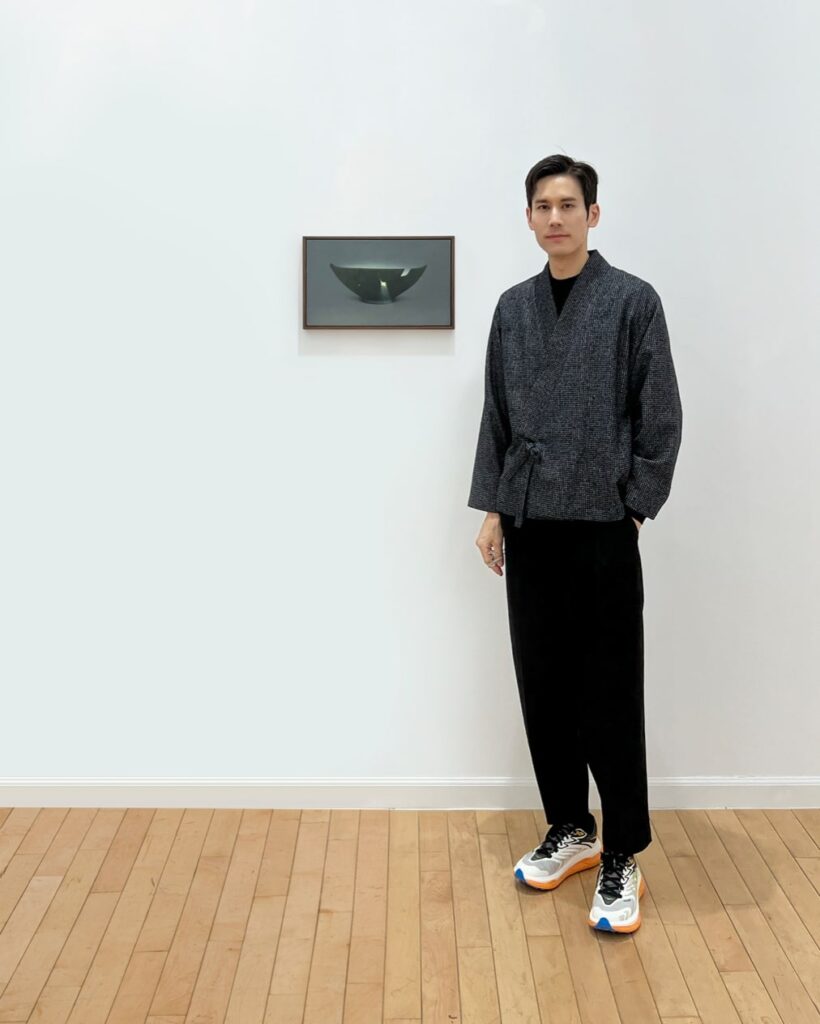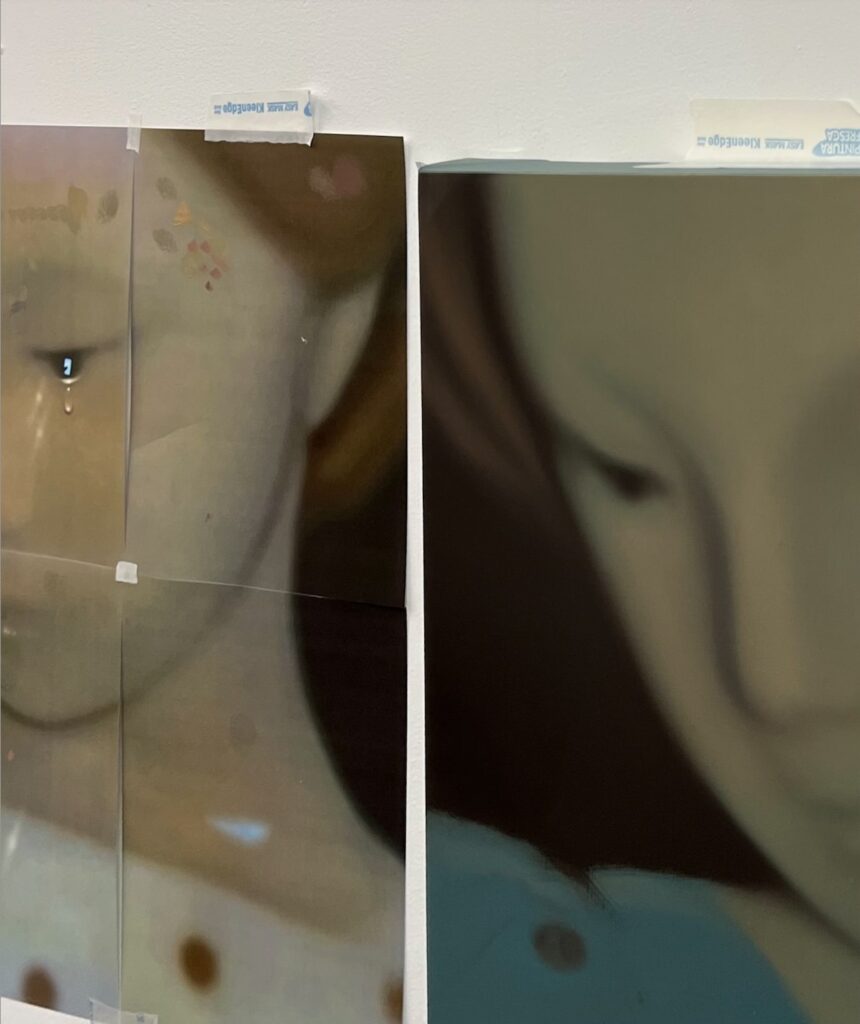Dabin Ahn (b. 1988, Seoul, Korea) received his BFA (2016) and MFA (2020) in painting from the School of the Art Institute of Chicago. Ahn’s work has been exhibited at venues including The Green Gallery in Milwaukee, WI; Edgewood College Gallery in Madison, WI; Mindy Solomon in Miami, FL; Hyde Park Art Center, Research House for Asian Art, and ARTRUSS in Chicago, IL; The Hole and Shatto Gallery in Los Angeles, CA; Marvin Gardens, Selenas Mountain, and Long Story Short in New York, NY. Most recently, his work was showcased on Platform (David Zwirner Gallery) and exhibited in a solo presentation at Ochi Gallery (Los Angeles) in December 2023. Ahn currently lives and works in Chicago, IL.
ON VIEW

Ahn’s first solo exhibition in New York City, Dabin Ahn: Silent Whisper, opened in March of 2024 at 1969 Gallery in Tribeca and runs through April 20th.
EXERPT FROM RECENT PRESS RELEASE
The figures in Ahn’s most recent body of workemerge from an inky twilight mist. Some have stepped out of the looking-glass worlds of illustrated Goryeo pottery, their porcelain skin glinting under artificial moonlight or in the soft candlelight of intimate offscreen moments. Others remain trapped in the convex surfaces of centuries-old urns and vases. Part celadon, part celluloid, they reach through the strata of time and layers of mimetic artifice to communicate their emotional truths. Each of his new paintings is its own phantasmic mise-en-scène, a startling, seductive world-within-a-world. At the same time, Ahn invents playful ways to consciously pierce the veil of illusion, as when he paints on the sides of his canvases, thereby affirming the material truth of paintings as objects. A philosophical meditation on the nature of representation, Ahn’s workalso explores real human emotions. Inspired in part by Shakespearean soliloquies and similar moments in cinema when actors break the fourth wall to communicate their innermost thoughts directly to an audience.

Hi Dabin, it’s a pleasure to sit down with you! First question that I always ask. How does a regular day look like for you in Chicago?
I live nearby my studio (15-minute bike ride), so I’m almost always in my studio at some point during the day. Even if it’s just to vacuum the floor or water my plants, I find it important to maintain a routine centered around my studio to keep the momentum going.

Being that you were born and raised in Seoul, Korea, what brought you to Chicago?
My life away from home began in a small town near Boston back in 2000 as a 6th-grade middle school student. I moved on to high school in New Jersey and then spent the next two years (2007-09) at Pratt Institute (Brooklyn, NY), where I started to dream of becoming a full-time artist. Following my sophomore year at Pratt, I had to take a leave of absence to serve the mandatory Korean military service. After 25 months, I was discharged from the ROK Air Force in 2011 and began showing my work in Seoul. Instead of my initial plan to return to Brooklyn to complete my bachelor’s degree at Pratt, I wanted to start the next chapter of my life in a different city. I received my BFA (2016) and MFA (2020) in painting from the School of the Art Institute of Chicago and currently based in Chicago.

I gotta ask Dabin. While I was doing my research for this interview, I find out your father is a famous actor. Especially in Korea. What was it like growing up with him as a kid? And did your parents support your artistry growing up?
Growing up, I’ve seen my dad (Sung-ki Ahn) leave the house with low energy and then appear on TV live a few hours later with his iconic smile, giving the best energy he could give to the audience. His professionalism has had the greatest influence on me and I learned from him the most. When I was little, we would watch Hollywood movies together and he would explain to me all the camera tricks and CGI. It was FASCINATING to me that this entirely made up (in a rather tedious and unromantic way in a cigarette smoke filled movie sets, I know because my dad took me to his sets) thing could make millions of people laugh or cry- generate a sense of emotion that one did not feel before sitting down to watch a film. By the age of 11, I’ve already familiarized myself with all these “cinematic” devices such as monologue and soliloquy and understood why they are necessary in films but may feel out of place in the real world (ex. everyone speaking their thoughts out loud in the streets).

Alright, so when did you start to paint, and when did you start taking being an artist seriously?
Making art was once a way for me to escape. I struggled academically throughout high school and the only time I would be recognized as a “good student” would be in art classes. While many of my friends were aiming to get into the “Ivy League” schools, my only goal was to begin the long journey of becoming a painter at an art school. First few days into my freshman year at Pratt, I knew this was what I’ve always wanted to pursue.

Having spent more than a decade in America, has that influenced your work?
I personally think what influences my work is not necessarily where I’m based, but having spent many years in the US, it does make me more conscious when choosing to depict subject matters that are of Korean origin.
Can you tell me about what brought you back to painting vessels after almost 10 years?
While I like to plan out the entire process for each work, one thing that hasn’t changed in my practice is believing in my intuition and just letting things naturally occur. My primary subject for my paintings was ceramic vessels between 2010-2013. When I came to Chicago to finish my degree in 2014, I had the urge to try new things and make experimental works including abstract paintings and installations. Having reintroduced vessels in my work after almost 10 years, they visually resemble my early still-life works, but these new paintings have stories and convey emotions unlike my older works that were more focused on just the technical side of painting.

You’re one of the only artists I’ve seen who paints on the sides of the canvas. When did you start doing that, and what made you start using the sides as the primary canvas to paint on?
The very first time I used the sides of the canvas to paint was exactly a year ago. I had this idea to make a painting where I would paint candles on both edges of the canvas, leaving the face of the painting with just the slightest hint of the glowing candlelight. I eventually made different variations of paintings using the sides and I plan to continue to use the idea in my future works.

What is it about objects such as candles and vases that resonates with you?
There is a sense of longevity, ephemerality, delicacy, and brittleness when I think of them. Vessels in my paintings absorb and then reflect candlelight towards viewers. This simple gesture is all I need for now to bring out the subtle emotions I’m trying to deliver through my paintings.
With that in mind. What makes an everyday object worthy of gracing one of your canvases? What are you looking for? There is a sadness to some of your work. Where does that come from? And what are you hoping to convey?
I look for objects mostly on museum archives. If I search with the keyword ‘celadon’ on the National Museum of Korea archives, I get pages after pages of images and information on 26,555 artifacts. While all these objects may hold historical significance, I find maybe one or two on average (per day) that really pull me in. Lately, I’ve been much more drawn to vessels with imperfections or even fragments that used to be part of a complete vessel. I’m depicting these flawed objects as metaphor to how we as humans face sadness. However, there will always be hints of notion of hope and positiveness in my works.

What motivates you?
Seeing other artists share their process and this accumulative process finally coming to fruition (exhibitions).
How do you deal with creative blocks?
Luckily, I never had any major issues of feeling creatively blocked, but I noticed I had a good momentum when I used to work on paintings and sculptures simultaneously. I would arrive at my studio and either pick up my paintbrush or go for the carving tools depending on how I felt each day.

Can you walk me through your creative process. From beginning, to end result? Being born with red/green colorblindness, can you tell me about how you approach color?
Part of the early stage of the process involves gathering, editing, and rendering various image sources digitally. Once the rendering is completed, I print out the image to use as reference when working on the actual paintings or sculptures. Being a painter with colorblindness, one method I use to get the right color is to mix color on my palette and then testing it over the printed image. If the color is accurate, the less visible the brush stroke becomes over the according parts of the image.

Ok Dabin, so I know that besides painting you also make sculptures. When did you get introduced to sculpting, and what makes it one of your preferred ways of expressing yourself?
I started to incorporate sculptures into my practice during grad school. I really enjoyed taking the same subject and realizing the idea through both canvas paintings and sculptural works. I can’t forget the first time I presented my paintings and sculptures together in a show because it was as if they were having conversations.

I always ask these two questions at the end of an interview. The first is. What’s your favorite movie(s) and why?
While movies had a great influence on me growing up, ironically, I rarely watch movies these days. When making new works in my studio, I find it more ideal to listen to things than to watch. I’ve been a huge fan of stand-up comedy for quite some time. Some comics would make up stories or exaggerate things for the sake of entertainment, but if you find the right ones, it feels better than watching movies or documentaries because it’s about story telling- which is EXACTLY what I’m trying to do every time I make a new work. Ali Siddiq is by far one of the best story tellers I’ve listen to. Here are two of his specials that I keep coming back to whenever I need to reorganize my thoughts between making works.
The Domino Effect by Ali Siddiq Pt.1
The Domino Effect by Ali Siddiq Pt.2
The second is. What song(s) are you currently listening to the most right now?
Having played music through different occasions as a DJ, all I listen to when it comes to music is live DJ sets. I listen to a very wide range of genre, from early 2000’s techno and trance to the latest hip-hop and house music. The point is, regardless of the genre, listening to a live DJ set (good DJs will make the entire set sound like a single track) helps me stay focused in my studio opposed to listening to individual songs with inconsistent melody and tempo.

